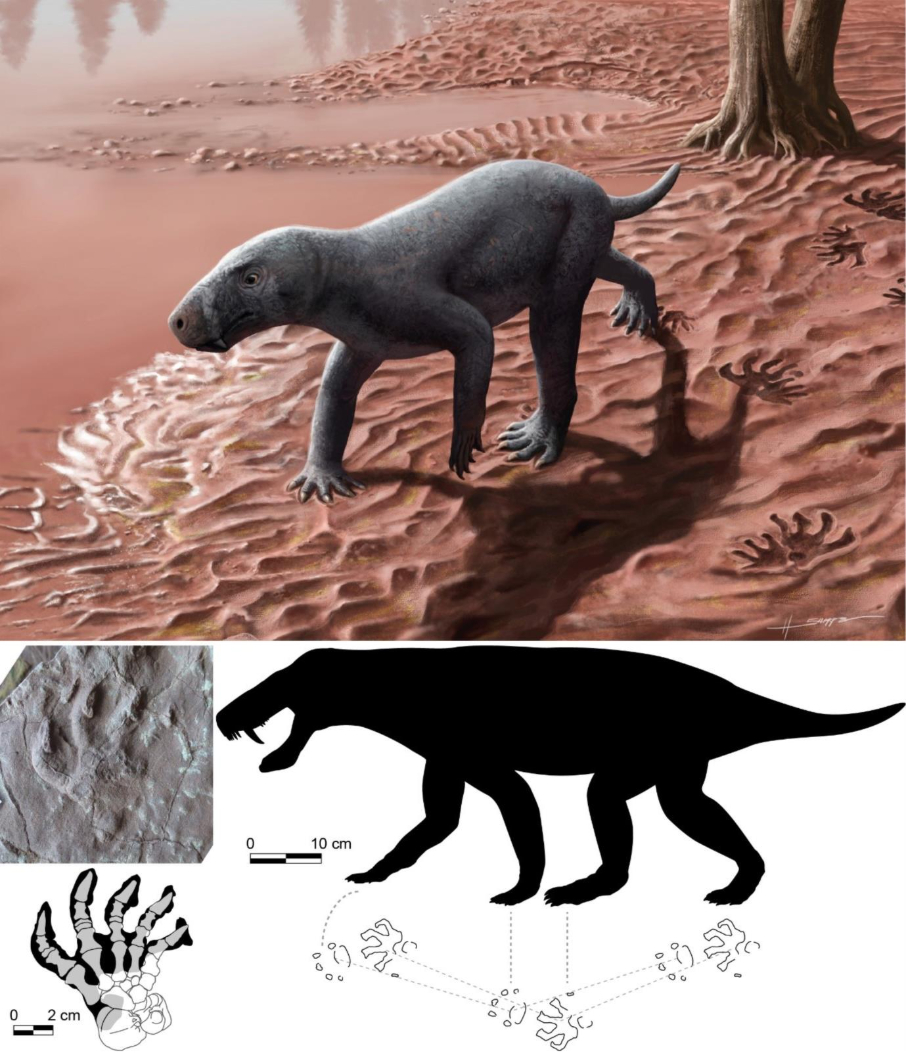A research team discovered in Banyalbufar (Serra de Tramuntana, Mallorca) a new trace fossil morphotype attributed to a gorgonopsian. This group of sabre-toothed predators from the Permian is related to the ancestors of mammals. The footprints are between 270 and 280 million years old and were discovered very close to the bones of this animal. They allowed to infer the mode of locomotion of the gorgonopsian, being closer to that of the mammals than to that of the reptiles. The findings are published in the journal Palaeogeography, Palaeoclimatology, Palaeoecology.
In the last few years, Mallorca has delivered exceptional fossils from the Permian period, between 270 and 280 million years ago. Among them, Tramuntanasaurus (a new reptile species described in 2023) and, more recently, the partial skeleton of a gorgonopsian (the oldest therapsid known so far) stand out. Gorgonopsians were among the predators of their time, with sabre-like teeth, superficially resembling a dog, but without ears and hair.
The study was conducted by researchers from the MUCBO | Museu Balear de Ciències Naturals, Staatliches Museum für Naturkunde Stuttgart (SMNS), Institut Català de Paleontologia Miquel Crusafont (ICP), and Museu de la Conca Dellà (MCD). They described new fossilised footprints from the same rock unit in Banyalbufar (Mallorca), where a few years ago the skeletal remains of a gorgonopsian were recovered.
Fossil footprints, or ichnites, are useful to understanding how extinct organisms moved and interacted with their habitat. Those described from Mallorca have a peculiar morphology and trackway arrangement, hitherto unknown in the fossil record. This fact led the researchers to give these footprints their own name, a new ichnotaxon to science: Algarpes ferus. Ichnotaxa are the scientific names assigned to each type of fossil footprints.
Analysis of the footprint shape and their relative position within trackways led to the identification of the animal that produced these footprints: a gorgonopsian. “Finding footprints and bones in the same rock units is extremely rare in the fossil record, and being able to correlate them is even more unusual”, says Eudald Mujal, co-first author of the study working at the SMNS (Germany).

Above, reconstruction of the gorgonopsian walking in its habitat (author: Henry Sutherland Sharpe©). Below, foot imprint compared with the reconstructed foot skeleton based on the gorgonopsian from Mallorca (left), and silhouette of a walking gorgonopsian based on the trackways preserved (right).
The tracks show that the animal had feet notably larger than hands, with robust digits terminating in large claws. Trackways indicate that the animal was walking with the legs vertical or erected, located almost underneath the body, and made very long steps —an exceptional feature in footprints that old. According to Rafel Matamales, co-first author of the study, palaeontologist and curator at MUCBO (Sóller, Mallorca), “this body posture is associated with animals closer to mammals than to reptiles”. So far, in the fossil record, this feature had only been identified in more modern therapsids. “Once more, the fossils from the Permian of Mallorca shed light on the evolution of the ancestors of mammals, in this case on their mode of locomotion”, Matamales concludes.
The transition from a body plan with sprawled legs to one with erect (vertical) legs represents a fundamental innovation associated to the evolutionary success of multiple vertebrate groups, like therapsids and dinosaurs. This anatomical transformation promoted a more efficient locomotion, facilitating a better mobility, and exploration and exploitation of different habitats. Therefore, the new fossil evidence from Mallorca becomes essential to understanding the global dispersion of the ancestors of mammals during the Permian. It reflects a crucial moment in the evolution of the locomotion that aided in their success.
Original article:
Rafel Matamales-Andreu, Eudald Mujal, Àngel Galobart, Josep Fortuny. (2025). Track-trackmaker correlation of co-occurring gorgonopsian bones and footprints from the early–?middle Permian of equatorial Pangaea. Palaeogeography, Palaeoclimatology, Palaeoecology 677: 113174. https://doi.org/10.1016/j.palaeo.2025.113174


